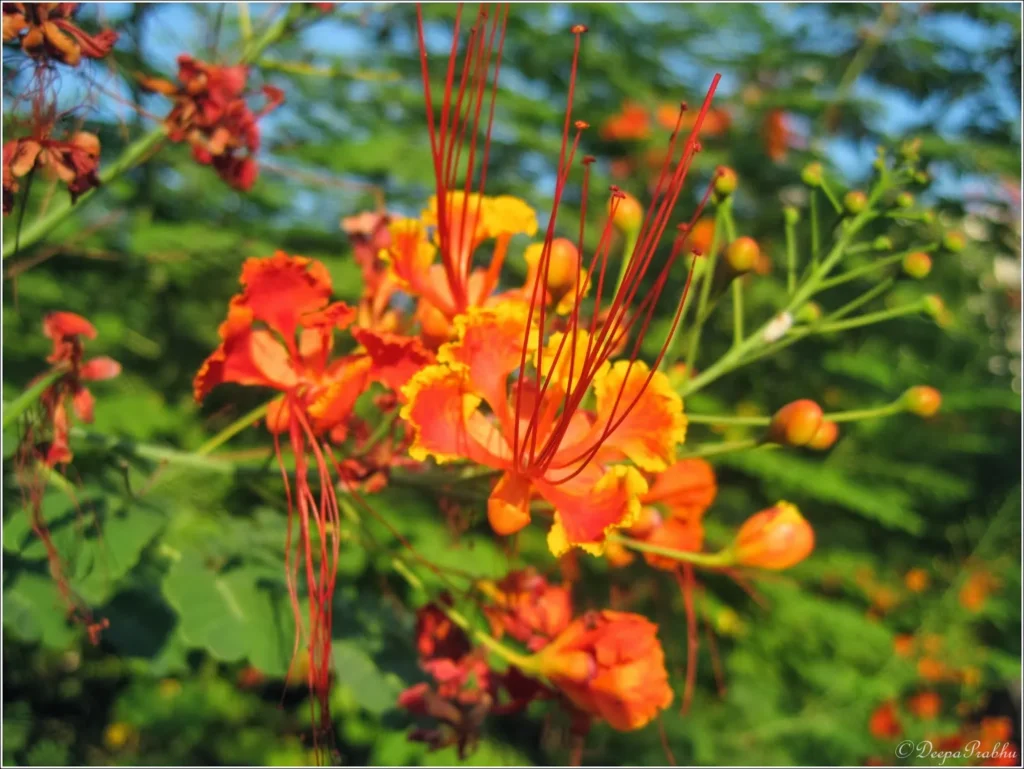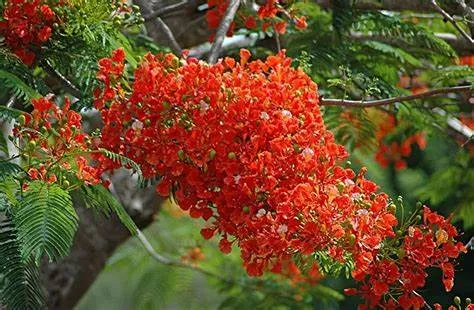Explore the vibrant world of the Gulmohar flower: Facts, Grow, Tips with our comprehensive guide. Discover essential facts, tips for growing, and how to care for this stunning Flame Tree to brighten your garden with its spectacular red and orange blooms.
Let’s explore the gulmohar flower, also known as Delonix regia. This vibrant and captivating tree is a true spectacle, especially during its flowering season. 🌺
- Overview:
- Delonix regia, commonly called gulmohar, is a species of flowering plant in the bean family Fabaceae.
- It hails from the island of Madagascar and was discovered by the naturalist Wensel Bojer in the early 19th century.
- Known for its flamboyant display, it goes by various names, including royal poinciana, flame of the forest, and simply flamboyant.
- Appearance:
- The gulmohar tree boasts fern-like leaves that create a light, bright green canopy.
- Its large flowers steal the show: they have four spreading scarlet or orange-red petals, each up to 8 cm (3 inches) long.
- The fifth petal, called the standard, stands upright and is slightly larger, adorned with yellow and white spots.
- These striking flowers cluster along the branches, creating a vivid spectacle.
- Flowering Season:
- During spring and summer, the gulmohar tree bursts into exuberant clusters of flame-red flowers.
- Imagine a tree covered with blooms that are 4-5 inches across—truly a sight to behold!
- Other Names:
- Apart from gulmohar, this tree goes by several other names:
- Royal Poinciana: A fitting title for its regal appearance.
- Krishnachura: A name that evokes the vibrant hues of Lord Krishna.
- Peacock Flower: Perhaps inspired by the rich colors reminiscent of a peacock’s plumage.
- Apart from gulmohar, this tree goes by several other names:
- Global Presence:
- While native to Madagascar, the gulmohar has been introduced to tropical and subtropical regions worldwide.
- It thrives in places like:
- South Florida and Central Florida in the United States.
- Hawaii.
- Mexico, especially in states like Campeche, Chiapas, Oaxaca, Tabasco, Veracruz, and Yucatan.
- Various Caribbean islands, including Dominica, Saint Lucia, and Trinidad and Tobago.
- Garden Marvel:
- In gardens, the gulmohar stands tall, its bright crimson flowers stealing the spotlight.
- Its umbrella-shaped canopy provides shade, and the whole tree becomes a canvas of fiery beauty.
Remember, when you encounter a gulmohar, take a moment to appreciate nature’s artistry—the fiery petals against the green backdrop—a true marvel! 🌿🔥🌸

How do I grow a gulmohar tree?
Growing a gulmohar tree (Delonix regia) can be a rewarding experience. Here are some essential steps to help you cultivate this magnificent tree:
- Soil and Location:
- Soil: Gulmohar is native to Madagascar, so it thrives in tropical regions. Choose well-draining soil with a pH range of 6.5 to 7.5.
- Sunlight: Gulmohar loves sunlight! Ensure it gets plenty of direct sunlight for optimal growth.
- Space: These trees need room to spread their branches, so select a spacious spot in your garden.
- Seed Preparation:
- You can grow gulmohar from seeds. Here are two methods:
- Scarification: Weaken the outer seed coat by gently scratching or cutting it. This helps the seed germinate more easily.
- Hot Water Soaking: Soak the seeds in hot water for about 10 minutes before sowing. This improves germination.
- You can grow gulmohar from seeds. Here are two methods:
- Planting:
- Plant the prepared seeds in the soil at a depth of about 1 inch.
- Water the soil gently after planting.
- Maintenance:
- Watering: Keep the soil consistently moist during the initial growth stages.
- Pruning: Regularly prune the tree during the winter months when it’s dormant. Pruning helps maintain its shape and promotes healthy growth.
- Fertilization: Apply a balanced fertilizer during the growing season (spring to summer) to encourage lush foliage and vibrant blooms.
- Pest Resistance: Gulmohar is generally resistant to pests, but protect its vulnerable wood from animals and insects.
- Blooming and Beauty:
- Gulmohar flowers bloom between April and May, creating a fiery display of scarlet and orange hues.
- The leaves turn yellow and shed around November.
- Enjoy the delicate aroma and shade provided by this ornamental tree.
- Cultural Significance:
- In Kerala, gulmohar is considered sacred.
- It serves as the city flower of Selangor and Malaysia.
- Commercial Uses:
- The wood is used for fuel (calorific value: 4600 kcal/kg).
- Gulmohar flowers are used in producing bee forage.
- The tree produces a thick water-soluble gum used as a binding agent in manufacturing tablets and textiles.
Remember, patience and care will reward you with a stunning gulmohar tree that graces your surroundings with its vibrant blooms! 🌿🔥🌸

What is the ideal temp for growing gulmohar?
The ideal temperature for growing the gulmohar tree (Delonix regia) aligns with its tropical origins. Here are some guidelines to ensure successful growth:
- Temperature:
- The gulmohar thrives in warm climates, much like tropical plants.
- For optimal growth, maintain a temperature of over 70°F (21°C).
- It appreciates humidity, so if you’re in a region with higher humidity, that’s a plus.
- Geographical Context:
- The hot belt regions of India are particularly suitable for growing gulmohar trees.
- These areas experience warm temperatures and provide an ideal environment for this flamboyant tree.
Remember, providing warmth and adequate sunlight will encourage your gulmohar tree to flourish and grace your surroundings with its vibrant blooms! 🌿🔥🌸
For more detailed information, you can explore additional resources here. 🌳
What is the ideal humidity for growing gulmohar?
The gulmohar tree (Delonix regia) thrives in warm and tropical climates, and humidity plays a crucial role in its growth. Here are some guidelines for maintaining the ideal humidity:
- Humidity Requirements:
- Gulmohar trees love moisture. They do well in areas with higher humidity.
- While they can tolerate varying humidity levels, they thrive best when the air is moderately humid.
- Hot Belt Regions:
- In India, the hot belt regions are particularly suitable for growing gulmohar trees.
- These areas experience warm temperatures and provide an ideal environment for this flamboyant tree.
- Temperature and Humidity:
- The ideal temperature for gulmohar plants is above 7.0°C.
- Gulmohar trees do remarkably well in the hot climate of India, where both warmth and humidity prevail.
Remember, maintaining a balance of warmth and moisture will encourage your gulmohar tree to flourish and grace your surroundings with its vibrant blooms! 🌿🔥🌸
How do I propagate gulmohar from cuttings?
Propagating a gulmohar tree (Delonix regia) from cuttings is an effective method. Here’s how you can do it:
- Select a Healthy Cutting:
- Choose a fresh, healthy stem from an existing gulmohar tree.
- The cutting should be about 1 foot (30 cm) in length.
- Ensure that it is free from pests or diseases.
- Prepare the Cutting:
- Remove all leaves from the lower portion of the cutting.
- This helps focus energy on root development.
- Rooting Hormone (Optional):
- While not necessary, you can dip the stem into a rooting hormone to enhance root growth.
- Potting Mix:
- Fill a one-gallon container with a well-draining potting mix or cocopeat.
- Make sure the mix is moist but not waterlogged.
- Plant the Cutting:
- Place the cutting carefully into the potting mix.
- Ensure that it is positioned upright and at the right depth.
- Lightly press the soil around the cutting to secure it.
- Moisten the Soil:
- Water the soil gently to provide moisture.
- Avoid overwatering; the soil should be consistently moist but not soggy.
- Patience and Care:
- Root development from cuttings takes several months.
- Place the container in a warm, sunny spot.
- Be patient and monitor the cutting’s progress.
Remember, propagating gulmohar from cuttings is relatively faster than growing from seeds. With care and time, your new gulmohar tree will thrive and grace your garden with its fiery blooms! 🌿🔥🌸
FAQs: Gulmohar flower: Facts, Grow, Tips
How to grow Gulmohar fast?
To encourage fast growth, plant Gulmohar in a well-draining soil mix, in a location that receives full sunlight for most of the day. Regular watering, especially in the tree’s early years and during dry spells, along with annual fertilization with a high-phosphorus fertilizer, can promote quicker growth and flowering.
What are the fun facts about Gulmohar?
- Gulmohar is known as the “Flame Tree” due to its vibrant red flowers that resemble flames.
- It is not native to India, despite its popularity there; it originally comes from Madagascar.
- The tree’s flowers have five petals, with one petal typically being slightly different in color, marked with yellow or white.
What is the planting distance of Gulmohar?
Gulmohar trees should be planted at least 20 to 25 feet apart from each other and from any structures. This allows enough space for their wide-spreading root system and canopy to develop without interference.
Is Gulmohar a summer flower?
Yes, Gulmohar is a summer-flowering tree. It typically blooms from late spring to early summer, providing spectacular color during these months.
How can I make my tree grow faster?
- Ensure it is planted in a sunny location.
- Water it regularly, but avoid waterlogging.
- Apply a balanced fertilizer during the growing season.
- Mulch around the base to retain moisture and reduce temperature fluctuations.
How long does Gulmohar tree live?
A Gulmohar tree can live for around 40 to 60 years, sometimes even longer under optimal conditions.
What is Gulmohar called in English?
Gulmohar is commonly known as the “Flame Tree” or “Royal Poinciana” in English.
What is the real name of Gulmohar?
The scientific name of Gulmohar is Delonix regia.
Why is Gulmohar tree important?
The Gulmohar tree is important for several reasons:
- It provides shade with its wide-spreading canopy, making it a valuable tree for hot climates.
- Its vibrant flowers add aesthetic value to landscapes.
- The tree is used in agroforestry systems for its ability to improve soil fertility.

Thanks for sharing. I read many of your blog posts, cool, your blog is very good.
I’m really glad to hear that my article helped you feel hopeful!
I don’t think the title of your article matches the content lol. Just kidding, mainly because I had some doubts after reading the article. https://www.binance.com/id/register?ref=GJY4VW8W
Your point of view caught my eye and was very interesting. Thanks. I have a question for you.